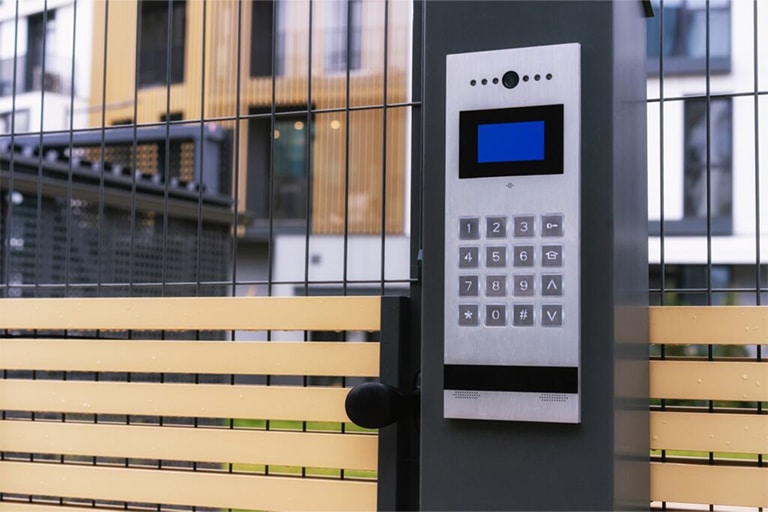As a member of the HOA board, you want the community to be safe and convenient for your residents. A gate access control system is a great way to improve their living experience and can make property management so much easier. This article will discuss the benefits of virtual gate access control for your HOA property.
What is a Virtual Access Control System?
A virtual access control system allows control over who has permission to enter a property, as well as how often and when. It can be installed by leveraging different security technologies at any gated entrance, including a slide gate, swing gate, or vertical open gate. There is a variety of different systems that are made for gated entrances. By choosing the appropriate one for your property, you can ensure that your HOA community will be a safe and comfortable place for your residents to call home. Since the access control system is virtual, you don’t need to hire someone on-site to monitor it.
Why You Need a Virtual Access Control System
The reason a community is gated is to keep residents safe and secure. However, you also need to make sure that residents and authorized visitors can gain access to the property. A virtual access control system allows you to keep the gate locked while making sure that residents are able to enter easily.
Some benefits of installing a virtual access control system include the following:
- Residents/visitors don’t have to wait for permission to enter the property
- No more car stacking at the entrance during peak times
- Visitors can request access from the resident or a staff member of the property
- Package deliveries are much easier
Living in a gated community can be pleasant, comforting, and even luxurious. A virtual gate access control system can offer a feeling of safety and security.
Ways to Control Gate Access
Once you have the appropriate security gate installed, you must think about how you plan to control access to your HOA community so that it’s secure, but not too complicated for those who have permission to be there. There are five ways you can do this:
- Intercom at gate
- Telephone at gate
- Key fob or key card
- License plate readers
- Keypad
Intercom at Gate
Installing an intercom at the gate is one of the most popular ways to manage gate access. An intercom system is a low-maintenance, cost-effective solution to allow access for residents, guests, and deliveries through the gate. Plus, surveillance systems can be connected to many modern intercom systems, so all the security info is in one place.
Consider installing a gate intercom with a built-in camera. This way, residents can see who it is at the gate before letting them in. Plus, you will have a log of all gate openings with time and date stamped photos.
You may want to consider using a cloud-based gate intercom so that you can access entry logs and make adjustments to access permissions from anywhere. These usually include a mobile app, so that staff and residents don’t need remotes or key fobs to enter the property. Residents can also allow guests and delivery drivers to enter from their smartphones.
Telephone at Gate
This is the oldest type of gate access control. It allows visitors to call the resident or the office via telephone. There are a few disadvantages to using this type of gate access control:
- Installation requires extensive wiring, which can get expensive.
- A telephone can’t be used by residents to open the gate themselves. It only offers a way for visitors to be granted access.
- It doesn’t pair with a mobile app for smartphone access control.
Though they have been used for many years, this type of gate control access is now considered obsolete and has been replaced by other options, such as cloud-based intercoms with video.
Key Fob or Key Card
Another option to control gate access in your HOA community is with a key fob or key card system. Each resident will receive a fob or card that they will scan when entering the front gate. This is great for residents, but doesn’t work well for visitors. Plus, fobs and cards may get lost, which is time-consuming and expensive to replace. If you do this, you’ll also need a visitor management system in place for guests.
License Plate Readers
A license plate reader scans the license plates as vehicles enter, and if they are in the database, the gate will open. However, this only works for residents. It does not allow entry for visitors or delivery drivers. Another entry management system will be needed for them.
Finally, a license plate reader will only control access through the front gate, not at any of the entrances to the amenities. You’ll need something else for that, as well.
Keypad
A keypad allows residents access without worrying about a fob or remote. Each resident will have a unique pin number they will use to gain access. However, guests and delivery drivers won’t have a code, and visitors have no way of requesting access from residents with a keypad.
Conclusion
As you can see, there are several benefits to virtual gate access control. With virtual gate access control, you can leave security in the hands of professionals rather than dealing with it yourself. Check out our Virtual Guard page to learn more about what we can do for your HOA community.






